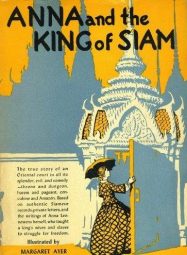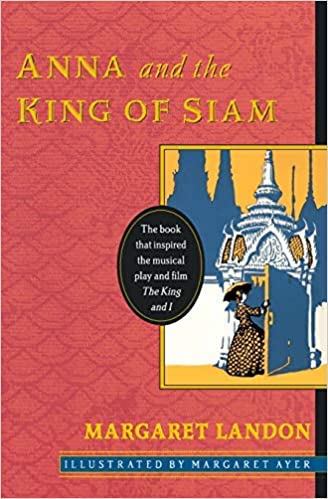Marching Through the Years: Revisiting Anna and the King of Siam
By Marcie McCauley | On September 15, 2021 | Updated January 28, 2024 | Comments (0)

When I was a girl, the only parts of grown-ups’ movies that I enjoyed were the parts with children in them. So, the first few times I watched the Rodgers and Hammerstein musical (based on the 1944 book Anna and the King of Siam by Margaret Landon) The King and I, only “The March of the Royal Siamese Children” appealed to me.
As an only child, families with more than one child seemed remarkable; the seemingly endless stream of offspring, parading through the court in this colorful musical number, fascinated me.
And I was oblivious to the number of grown women—the mothers—also in attendance, felt no compulsion to multiply by nine, or to muse on multiple conceptions.
As a teenager, I accepted my discovery of Margaret Landon’s Anna and the King of Siam as the “true story,” just as I accepted that The Sound of Music was based on the well-worn paperback copies of Maria Augusta von Trapp’s memoirs that had long resided in my grandmother’s bookshelves.
This is to say that I understood, in theory, there were real-life figures behind these musicals, but I preferred the song-and-dance inventions.
A construction of a construction
Had I read the author’s note at the end of Margaret Landon’s narrative (though I likely dismissed it as the kind of thing one read for “homework,” not for fun), I would have realized that Anna’s story was not being chronicled directly even there—that Margaret was constructing a story about Anna’s life based on Anna’s previous construction.
Margaret first became fascinated by Anna Leonowens’ (1831–1915) 19th-century experiences teaching in Siam when she herself taught there several decades later. A family friend loaned her copies of Leonowens’ memoirs—The English Governess at the Siamese Court (1870) and The Romance of the Harem (1872)—which were difficult to obtain given the Siamese government’s disapproval of some of Leonowens’ characterizations.
This is how Margaret describes her friend Dr. McDaniel’s introduction to the works in her author’s note:
“Here’s something you ought to read. The Siamese government did everything in their power to keep it from being published. I’ve been told they even tried to buy the whole edition to prevent its distribution. In fact there has been so much feeling against the book that I still keep my copy out of sight, just to be on the safe side.”
. . . . . . . . . . .

Anna Leonowens (1831 – 1915)
. . . . . . . . . .
Studying Anna Leonowens
After the Landon family returned to the U.S.and Margaret located personal copies of the books, she began to study Anna in detail.
But she found it impossible to reassemble her narratives completely and sequentially, even after eliminating much of the description and heavily detailed material, so she proceeded with a third-person narrative: “seventy-five percent fact, and twenty-five percent fiction based on fact.”
Both Anna Leonowens’ The English Governess at the Siamese Court and Margaret Landon’s Anna and the King of Siam open in 1862, onboard a steamer docking in Bangkok. Both writers are concerned with setting a scene, with inviting readers into an unfamiliar space, but even the first dozen pages reveal the stark difference in style, content, and perspective.
Anna immediately focuses on the sunrise, which she admires on deck, then shifts to descriptions of flora and fauna, the river and fishing industry, and the islands and architecture visible from her perspective. From her “early glimpse of this strange land,” it is the land she seeks to display, along with the culture of that land’s inhabitants, including some native language.
The human-interest elements (dogs and circus personnel), and the emotional details surrounding uncertainty about her accommodations, pique readers’ interest, but Anna’s personal record is more travelogue than entertainment.
Margaret begins with the circus and the dogs, then quickly puts Anna in the spotlight: her clothing and hairstyle, her bearing and tone, her reassurance to her son about their journey’s end. Anna is the story: after a deftly sketched scene that showcases her courage and conviction, she prepares to leave the ship. Margaret then ventures into material unrecognizable from Anna’s memoir.
Contextualizing Anna
In Margaret’s research, she initially lacked context for Anna’s actual experiences beyond her publications. And although Margaret found Anna’s “long descriptions far from dull,” she recognized that not everyone shared her interest in South Asia.
She hoped to “piece together” Anna’s “own writings without alternation in language or style,” and depend upon her personal experience of Siam and its history to more swiftly engage western readers.
Then, in 1939, Margaret’s access to information broadened when she attended a luncheon with her husband, whose mission work had originally taken the couple to Siam.
One of the other ministers in attendance, who was familiar with the couple’s work there, mentioned to Margaret that his mother would love to discuss a long-ago correspondence that she had had, years before, with another woman who had also taught there.
Gerald Gratton Moore’s mother had not only corresponded with Anna Leonowens, but she was able to connect Margaret Landon with Anna’s granddaughter, Miss Fyshe, then living in Montreal. The documents that Miss Fyshe possessed included an account that Anna had prepared to describe her pre-Bangkok years.
Margaret’s second chapter veers into fresh territory and casts a backward glance at what Anna describes as youthful experiences in Wales and India. Margaret understood these to have prepared Anna for travels far from her home.
With these additional materials, Margaret was able to develop her fictionalized version of a strident teacher, whose integrity and faith could serve as an example for American women in wartime and beyond.
These materials, however, were described by biographer Alfred Habegger as a “publicity release,” though Margaret could not have known they were “utterly unreliable.”
Developing a personal vision
Though Margaret was dedicated to research and accuracy, she fundamentally trusted Anna’s recounting of events and became increasingly committed to her personal vision of Anna.
Even in the face of editorial doubts, for instance, Margaret insisted that Anna’s religiosity remain prominent in the story. She doubled down on elements of the imagination that presented Anna as a valiant and worthy heroine.
Habegger, for instance, refers to the evolution of Margaret’s drafts, which widened the gap between the characters of Anna and the King of Siam. “Loyalty to the one meant defacement of the other,” he explains. Above all, Margaret was loyal to her view of Anna as an infallible heroine.
In an early draft, Habegger observes, Margaret paraphrases Anna in her description of King Mongkut (the ruler of Siam from 1851 to 1868), who “in many grave considerations displayed a soundness of understanding and clearness of judgment, a genuine nobility of mind, established on ethics and philosophic reason, that were wholly admirable.”
Habegger observes that “nothing resembling the sentence” remains in the published volume, however; ultimately “paraphrase had yielded to fiction” and “gone…was the respect for Mongkut’s intellectual character.”
For me, as a young viewer, it was all about Anna. Once the adults began to interest me, Anna occupied the heart of the story (largely because of her hoop skirts but also the sentimentality of the film’s ending!) but, over the years, the King captured my interest.
. . . . . . . . . .

Yul Brynner, 1956. ©20th Century Fox Film Corp. Courtesy: Everett
. . . . . . . . . .
Yul Brynner — personification of the King
The King who commanded my attention was not the King as presented by Anna or Margaret or the 1946 Twentieth Century Fox dramatic film production (titled Anna and the King, starring Irene Dunne and Rex Harrison).
It was Yul Brynner who would captivate me; he first played the King in the original stage musical in 1951 with Gertrude Lawrence as Anna, then starred opposite Deborah Kerr in the 1956 musical film (Kerr had voiced Anna in the 1949 radio production).
Brynner was also cast in the 1972 Twentieth-Century Fox television series on CBS, based on the film and also titled Anna and the King, opposite Samantha Eggar. It lasted only one season and provoked litigation from Margaret Landon.
This perhaps explains why the Twentieth-Century Fox Anna and the King, released in 1999 and starring Jodie Foster and Chow Yun-Fat, was said to have been based on Anna’s writing — not Margaret’s. That same year, Walt Disney released an animated version.
For me, the King is personified by Yul Brynner. In a 1981 interview, Brynner discussed his belief that the story has endured because the figures were based on real people — not stereotypes, but rather, archetypes. The King, he elaborated, is the archetypal father, presented as both dangerous and loving, possessing seemingly contradictory traits, like roughness and innocence.
Although Brynner portrayed the King in both television and film, in the interview he referred to his stage performances—eight per week over many years, and around the world.
One moment fascinated Brynner in particular, a moment of violent emotion in which the King’s inherited totalitarian value system conflicts with Anna’s democratic value system. Brynner discussed the evolution of his representation of this internal turmoil.
Even after performing the role thousands, of times, he found new meaning in the King’s contradictions and complexity. And, in the same interview, he agreed that the most moving piece of music is the “March of the Children.” Because, he explained, it represents “respect for the individual human being,” a simple but powerful truth, that children will grow up and become unique individuals.
. . . . . . . . .

. . . . . . . . .
One reader’s ignited imagination
When I was a girl, just beginning to watch this story, I always imagined myself as one of two girls: she who presents Anna with a flower, or she who forgets the court protocol and rushes in for a hug from her father, only to be rebuffed but quickly reassured by a not-quite-concealed playful smirk when she takes her proper place in the court.
Neither of these girls appears in the story as told in Anna Leonowens’ The English Governess at the Siamese Court or Margaret Landon’s Anna and the King of Siam, but were it not for these women’s narratives, I would have had one fewer pantomime to play at in my only child’s repertoire; I would have been doomed to endless hours of “playing” The Sound of Music in Europe’s mountains, without the opportunity to imagine myself as a young princess in Siam.
. . . . . . . . .
Contributed by Marcie McCauley, a graduate of the University of Western Ontario and the Humber College Creative Writing Program. She writes and reads (mostly women writers!) in Toronto, Canada. And she chats about it on Buried In Print and @buriedinprint.
Stage and film adaptations of Anna and the King of Siam
- Anna and the King of Siam (1946 film)
- The King and I (1951 stage musical)
- The King and I (1956 film musical)
- Anna and the King (1972 TV series)
- The King and I (1999 animated film musical)
- Anna and the King (1999 film)
Leave a Reply